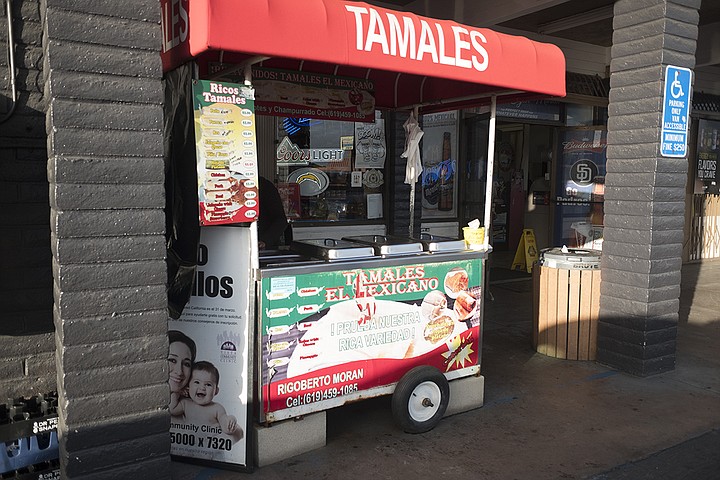 Facebook
Facebook
 X
X
 Instagram
Instagram
 TikTok
TikTok
 Youtube
Youtube

One of my favorite parts about living in San Diego is that I can be cruising down a street on just about any day and spot a little cart selling tamales. I noticed Tamales el Mexicano at its regular location, sitting in front of a liquor store next to a car wash on El Cajon Boulevard, just east of the 805. It’s not much to look at beyond the all-caps TAMALES, printed white on red, but that proved enough to lure me in for a mid-afternoon snack.
Despite a simple bilingual menu, it took me a moment to realize the beef and res tamales, listed separately, are the same thing. Same with the chicken (pollo), pork (puerco), and jalapeño with cheese (con queso).

One distinct offering offered no translation: hoja de platano. That’s a tamal steamed inside of a banana leaf instead of the traditional corn husk. And by traditional, I mean to northern parts of Mexico and most common in California. In the tropical states of Mexico such as Oaxaca, Veracruz, and Yucatan — where tamales were probably first eaten somewhere between three and five thousand years ago — they prefer banana leaves.
I’ve had each kind before but never tried them together, so I figured this was a good opportunity to compare them, head to head. The platano tamales only come with chicken or pork fillings, so I ordered the chicken, and then a corn husk tamal with pork. I watched as they were plucked steaming out of the cart and dropped into a plastic bag. It’s all para llevar from a tamale cart.
After a short ride home, I unwrapped the tamales. The corn husk tamal had a nicer presentation, wrapped in paper and tied at the ends like an old timey piece of candy. But my hungry fingers struggled to untie it cleanly. The untied platano was easier to get to, though no less greasy to unwrap.
Once I got down to eating, I assumed I would prefer the pork filling, but while it was stewed to a decent level of tenderness, its green salsa was mild in comparison to the savory red heat of the chicken. The masa of the banana leaf tamal had more of a yellowish hue and was noticeably more moist than its paler corn husk counterpart.
While the corn husk masa had the more crumbly texture, it’s the hoja de platano version that fell apart more easily, too succulent to hold its shape. Still, between the spicier filling and juicier chew, I give the corn husk the clear edge. It costs 50 cents more, but the bump in quality is worth it.
Neither are the greatest tamales ever, but if you’re passing by and in the mood to feel good about living in a culturally rich part of the country, they hit the spot.


One of my favorite parts about living in San Diego is that I can be cruising down a street on just about any day and spot a little cart selling tamales. I noticed Tamales el Mexicano at its regular location, sitting in front of a liquor store next to a car wash on El Cajon Boulevard, just east of the 805. It’s not much to look at beyond the all-caps TAMALES, printed white on red, but that proved enough to lure me in for a mid-afternoon snack.
Despite a simple bilingual menu, it took me a moment to realize the beef and res tamales, listed separately, are the same thing. Same with the chicken (pollo), pork (puerco), and jalapeño with cheese (con queso).

One distinct offering offered no translation: hoja de platano. That’s a tamal steamed inside of a banana leaf instead of the traditional corn husk. And by traditional, I mean to northern parts of Mexico and most common in California. In the tropical states of Mexico such as Oaxaca, Veracruz, and Yucatan — where tamales were probably first eaten somewhere between three and five thousand years ago — they prefer banana leaves.
I’ve had each kind before but never tried them together, so I figured this was a good opportunity to compare them, head to head. The platano tamales only come with chicken or pork fillings, so I ordered the chicken, and then a corn husk tamal with pork. I watched as they were plucked steaming out of the cart and dropped into a plastic bag. It’s all para llevar from a tamale cart.
After a short ride home, I unwrapped the tamales. The corn husk tamal had a nicer presentation, wrapped in paper and tied at the ends like an old timey piece of candy. But my hungry fingers struggled to untie it cleanly. The untied platano was easier to get to, though no less greasy to unwrap.
Once I got down to eating, I assumed I would prefer the pork filling, but while it was stewed to a decent level of tenderness, its green salsa was mild in comparison to the savory red heat of the chicken. The masa of the banana leaf tamal had more of a yellowish hue and was noticeably more moist than its paler corn husk counterpart.
While the corn husk masa had the more crumbly texture, it’s the hoja de platano version that fell apart more easily, too succulent to hold its shape. Still, between the spicier filling and juicier chew, I give the corn husk the clear edge. It costs 50 cents more, but the bump in quality is worth it.
Neither are the greatest tamales ever, but if you’re passing by and in the mood to feel good about living in a culturally rich part of the country, they hit the spot.
Comments